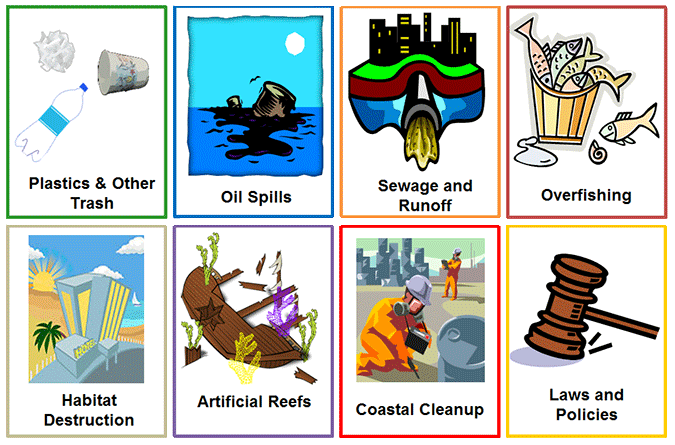

Plastics and Trash—In the United States and all over the world, sewage and trash are dumped into the sea. Approximately 7 billion tons of litter is dumped into the ocean each year. About 60 percent of that litter is made of plastic products such as bags, bottles, and plastic rings that hold canned drinks, such as sodas, together, etc. Wildlife gets entrapped in the plastics and dies from starvation.
Oil Spills—Oil spills in the ocean usually happen when an ocean oil drilling rig springs a leak or is damaged. Natural disasters such as hurricanes may also cause oil spills. Winds from a hurricane a couple of miles away could cause an oil tanker to flip over and pour out oil. Oil spills can also happen when an ocean tanker carrying oil wrecks. Oil dumped down storm drains that lead to the ocean also may be a source of oil in the ocean. Approximately 706 million gallons of waste oil enter the ocean every year, with over half coming from land drainage and waste disposal. Oil spills kill large amounts of fish. Oil spills impact the ocean and coastal fishing industry. They also alter the food chain of the ocean. Wildlife other than fish (plants, mammals, reptiles, amphibians, and birds) that live in or near the ocean are also poisoned by the oil waste.
Sewage and Runoff—Eighty percent of pollution in the ocean comes from land-based sources, such as runoff and sewage pollution. Runoff pollution includes many small sources, like septic tanks, cars, trucks, and boats, plus larger sources, such as farms, ranches, and forest areas. Natural fertilizers (animal waste) from ranches and pesticides for aerial spraying of crops can flow and enter the ocean. Farming can cause soil to erode and enter runoff. Sewage introduces diseases and unhealthy chemicals like heavy metals and carcinogens (cancer-causing agents) into ocean waters. Sewage and runoff alter the food chain in the ocean.
Overfishing—Many marine ecologists think that the biggest single threat to marine ecosystems today is overfishing. Overfishing occurs when the quantity of fish harvested or pulled from the ocean is greater than the amount that can be re-supplied by growth and reproduction. Giant ships use state-of-the-art fish-finding sonar to find schools of fish. The ships are like giant floating factories—they contain fish processing and packing plants and freezing systems and have powerful engines to drag enormous fishing equipment through the ocean. As you can imagine, depleting the fish population drastically alters the ocean food chain. Setting limits on fishing based on current fish populations and their ability to repopulate through growth and reproduction can help reduce overfishing.
Habitat Destruction (Coastal Development and Dredging)—Coastal development includes human activities such as the construction of beachfront homes, hotels, restaurants, and roads. Development along the coast increases the amount of runoff, agricultural pesticides, and sewage entering the ocean waters. It also destroys the habitat of beach-dwelling organisms. A trawl is a large net used to catch fish. The nets are dragged by ships across the ocean floor in a process called trawling. Trawling destroys the natural habitat of the ocean floor. When their habitat is destroyed, ocean life does not have the resources they need in order to survive.
Artificial Reefs—Ocean habitats have been destroyed by human activities such as costal development and dredging. The reduction of these habitats has led to a decrease in marine organism populations. An artificial reef is a human-made underwater structure, typically built to provide ocean animals and plants protection and a place to grow and reproduce. Reefs are built using materials such as concrete or limestone. Materials such as sunken oil rigs, sunken ships, or other construction debris can also be used to build artificial reefs.
Coastal Clean Up—Coastal cleanup efforts such as Ocean Conservancy’s International Coastal Cleanup have helped improve the ocean habitat. Over the past 25 years, Ocean Conservancy’s International Coastal Cleanup has become the world’s largest volunteer effort for ocean health. Nearly nine million volunteers from 152 countries and locations have cleaned 145 million pounds of trash from the shores of lakes, streams, rivers, and the ocean on just one day each year. Companies such as Exxon and Shell Oil also have coastal cleanup efforts several times a year.
Laws and Policies—Ocean laws and policies are important to protecting and conserving the ocean. Legislation provides guidelines for federal agencies to protect the ocean environment. The Coral Reef Conservation Act (CRCA) was created in 2000 to help preserve coral reef ecosystems. The Endangered Species Act (ESA) was passed in 1973 to protect animals from extinction. There are three major components of the ESA: listing species' as either threatened or endangered, designating habitat that is critical to the species survival, and restoring populations of species so they can be removed from the list. The National Marine Sanctuaries Act (NMSA) was enacted in 1972 with the purpose of designating important marine environments as sanctuaries for their environmental, historical, or cultural significance. Currently, there are 13 marine sanctuaries in the National Marine Sanctuary System, six of which were created after 1990. There are many other laws and policies to protect the oceans.